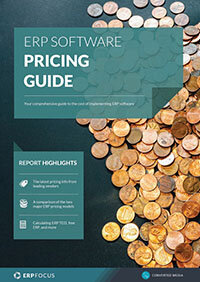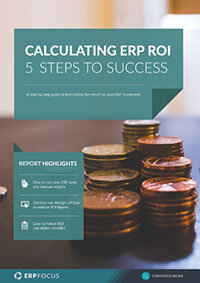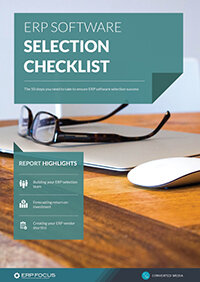Top 10 ERP selection criteria (including checklist)
ERP is a software tool we all use, and it is at the heart of our businesses, helping us achieve our goals.
Selecting the right system for our business is one of the most important decisions we will make. The decision has to be right. Here are some ERP system selection criteria that you should bear in mind during your selection project.
Always keep in mind what your business goals are when considering your ERP selection criteria, and how these may impact each element.
Top 10 ERP selection criteria:
- Business requirements
- Upper management support
- User support
- Functional requirements
- Integration with existing systems
- Budget and resources
- Technology and future scalability
- Total cost of ownership and ROI
- Evaluate and select options
- Necessary customization
Download your free ERP selection checklist to ensure you don't miss a step when choosing your ERP.
What are the criteria for selecting ERP?
When selecting an ERP, you should consider many factors, as this system will impact every aspect of your business for years to come. Every business' criteria for critical requirements will differ slightly, but you should ensure that your ERP system:
- Meets functional requirements for your business - the system does what it is supposed to and helps rather than hinders
- What industry experience your ERP provider has with companies like yours
- What user support do you need for your ERP system?
- How much does your ERP system cost? An ERP needs to be within your business budget
- How your system integrates with existing systems that will be staying - you need a system that works across your entire busines,s rather than many disparate systems
- What customization do you need from the out-of-the-box software?
We will answer these questions in our ERP selection criteria list below, but keep in mind your own business problems and how they apply to each set of criteria along the way.
ERP selection criteria #1: business requirements
Create a clear, detailed list of your ERP requirements. Gather input from everyone: production workers, purchasing managers, executives, customers, suppliers, and even former employees. Once complete, prioritize the list: identify “must-haves,” then “nice-to-haves,” and finally, lower-priority features. Focus on consensus to ensure the list reflects your company’s needs.
Take your priority list around to the same people who provided your inputs. Do they agree with the requirement list? Does it need to be updated? Can someone provide a solid case to elevate a point from tier 2 to tier 1? Much of every other criterion assumes this list is as good as it can be.

An ERP requirements template helps you break down features into specific functions, like automating recurring transactions or setting rules for GL calculations. This level of detail shows whether the software meets your needs out-of-the-box, through customization, or via third-party integration.
ERP selection criteria #2: upper management support
This could seem like an obvious criterion. Too often, it is not recognized for its importance. One can select the absolute best ERP for their organization, yet without upper management support, the project is likely doomed. Support goes beyond simply getting spending approval.
You want your management to actively embody their support. When a resource from another department is needed, the manager can throttle progress by providing lukewarm support. When a choice arises to support the new ERP or use the present system, you want confidence that the manager truly supports the ERP, even if there is a short-term cost at the point of the choice.
Pitching senior management for ERP project buy-in may seem daunting, but it is key to your project's success - alongside determining selection costs, you need to focus your business case on company goals and how ERP can help your organization achieve them.
ERP selection criteria #3: user support
People in every functional area will be users of the new ERP, so gaining their support is crucial. Include their needs in the requirements list and show them how the ERP’s success benefits both them and the organization. Ensure users have the training, tools, and support needed to adapt to the changes. Provide clear, accessible documentation to help them make the most of the system. In return, they’ll back your efforts to maximize ERP benefits.
ERP selection criteria #4: functional requirements
Your business has certain functional requirements that must be satisfied even before your change and update requirements. Does this ERP support sales orders that include both physical products related and services? If that is what your business sells, it has to. Your business operates in multiple countries around the globe. Do the accounting components of ERP include multiple currencies and the ability to work with a variety of tax systems in those countries?
Think about any ERP components not required by your business. If your business is distribution and you perform no manufacturing, can you easily work around any work-in-progress demands made by an integrated inventory system included in some ERPs?

Each department has specific needs, so your ERP selection should address them all. Supply chain teams need supplier integration and shipment tracking, while sales want support for territories and multi-tiered orders. Ensure every department's needs are considered in your ERP requirements.
ERP selection criteria #5: integration with existing systems
Most businesses considering an ERP selection have other systems that are quite adequate for their purpose, and the business is not interested in changing multiple systems along with their ERP. The question now to be asked: how will those systems integrate with ERP?
Almost always, there are common data elements. Can ERP read and use the existing data in that other system? Will you allow the same data to exist, and how will you keep those separately updated data elements compatible? Will you be better served by changing the other system to use that data from ERP?
What integration tools come with this ERP? It should have simple integration, such as .csv files for occasional data updates. That type of update is inefficient and likely too slow for everyday use. Web services and XML files that allow different systems to quickly transfer data between systems are a more modern way to work.
Many customers and suppliers use EDI (electronic data interchange) to share data between companies. If this is needed, be sure your ERP supports that need.
ERP selection criteria #6: budget and resources
How much money is available for an ERP system? If you only have $10, then you have to have a very strict selection criterion. A Software Path report stated that on average, you can expect to spend about $9,000 on each user of your system - that's a big investment and a reminder that ERP selection is a long-term consideration.
Most ERP systems will be used for a decade or longer, so ongoing maintenance and support for the ERP, as well as the infrastructure related are a budget concern. Your choice today will lock costs into future budgets.
Use our free ERP price and budget guide to calculate how much your ERP costs
Who is going to take the time and perform the work involved in selecting and implementing ERP? Ideally, you can devote full-time resources to the project but many businesses will want to use part-time resources. You need to plan who will perform the necessary work that those resources perform now while they devote time toward ERP.

Your ERP budget can vary based on business size. The latest ERP research from Software Path collated budget data from thousands of ERP projects to find an average cost per user for various business sizes.
Interestingly, their ERP project report also found that companies in the healthcare industry typically had a higher estimated budget per user.
Requirements, resources, industry, and company size are all factors you should include in your ERP selection criteria to find the right software.
ERP selection criteria #7: technology and future scalability
These concerns apply to the software used to develop your ERP system and to the hardware required to use that ERP. We know there will be ongoing developments and improvements in both domains. We might not want either to perform on the bleeding edge of technology, but neither do we want either one to use obsolete technology today. At the same time, we want to buy our ERP from a provider that has a good record of accomplishment of keeping up with technology developments and who promises to maintain that strategy.
ERP selection criteria #8: total cost of ownership and ROI
Add up all the incremental costs you will incur due to this ERP. There will be the initial purchase amount and some initial consulting expenses. You might need some updates to your servers and networks immediately. You will spend money on training and temporary labor while your people are implementing ERP. You will have support and maintenance costs every year while you use the ERP.
At the same time, you will benefit from improvements in the cost to perform work. You might see additional revenue because you can now provide services and products to your customers that were not possible without this ERP.
Spread those costs and benefits over time and calculate your return on investment. Most businesses have a threshold return needed before investing. Ensure that this ERP passes your business ROI threshold.
ERP selection criteria #9: evaluate and select options
The traditional ERP system running on an on-premises server and supported by an in-house IT staff is not the only choice today. Many businesses choose an ERP that runs in the cloud using a SaaS framework. The initial investment is reduced in favor of monthly “rental” payments that include the software and most support needs.
You can choose a hybrid approach where your business owns the ERP but operates it in the cloud, running on shared servers.
Many ERP systems today use open-source software, offering low-cost solutions and complete customization. With open-source, users worldwide update and fix bugs, instantly making improvements available to everyone, no waiting for new revisions.
If you have concerns related to these options, your choice will point to what ERP system selection criteria are essential for your business.
ERP selection criteria #10: necessary customization
The perfect ERP won’t need customization, but perfection is rare. Determine with your team which customizations are truly essential. Modern ERPs are built on knowledge from thousands of customers, so ask yourself: is your business truly unique? If a customization can be worked around or deferred, it’s not an immediate priority. However, the ability to add it later should be a selection criterion.
On the other hand, if your desired customization is required, look at ERP systems with an eye toward the ease and efficiency of that customization. Do you have developers skilled in the programming language required? Are developers with that skill available in the employment market?
How will your ERP handle the customization? Can you use business objects or other validation techniques to ensure compatibility with other components of the ERP? Can you introduce your customization with no adverse effects on other components of ERP?
Some ERPs available will have better answers to your questions than others will, and will help limit your available choices among ERP systems.
Bonus: ERP software selection checklist
Ensure your ERP selection project goes to plan using a full checklist. You should make sure to customize your checklist with your business needs beyond this, but our list should provide a good starting point. You can download our full ERP selection checklist to ensure you don't miss a step when choosing your ERP.
- Selection Team tasks
- Selecting your project lead
- Assembling your selection team
- Identifying a C-Level sponsor
- Requirements gathering
- Creating a map of your current business processes
- Identifying key business challenges
- Consult each department for their issues
- System specification
- How many users require access
- What hosting should you choose
- What language and currency requirements do you have
- Vendor services
- What support do you need
- Do you need an external project management team
- What are the critical data sets in your legacy systems
- ROI forecast
- Determine the timeframe for total cost of ownership
- Set up reporting on ROI forecasts
- Create a change management plan
- Vendor shortlisting
- Research ERP used by similar companies in your industry
- Compile your shortlist
- Create an RFP
- Selecting an ERP
- Build your selection team
- Review RFQ responses
- Agree to a purchase decision
The above checklist is a very condensed version of our complete ERP selection checklist with 60 steps you should take when selecting your ERP.
Now that you've reviewed our list and have the answers to all these enterprise software selection criteria, you are well on the way to selecting an ERP that serves your business now and for the future.
Free white paper

ERP Requirements template
Plan your ERP selection using our requirements template with 100 features in an editable spreadsheet. Include special requirements and extra detail in this exclusive template.

Featured white papers
-

ERP Software Pricing Guide
Get the latest pricing information on over 80 popular ERP systems, and learn how to budget for your ERP project in our free guide
Download -

Calculating ERP ROI: 5 steps to success
Calculate your new ERP's financial benefits with this comprehensive guide
Download -

60-Step ERP Selection Checklist
Get the comprehensive checklist for your ERP selection project
Download
Related articles
-

Nine signs you need an eCommerce ERP integration
A guest blog from Brightpearl discussing eCommerce ERP and integration
-

CMMC Compliance: What Aerospace and Defense Manufacturers Need to Know
Key insights on CMMC compliance, deadlines, and securing DoD contracts with CMMC 2.0 certificatio...
-

The best ERP systems for process manufacturing
Consider these ERP systems when selecting your next process manufacturing ERP

